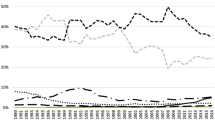Abstract
This article makes an empirical study on the magnifying effect produced by foreign direct investment (hereafter called as FDI) on the US-China trade deficit through co-integration analysis and error-correction modeling. By combining the empirical results, we give out our own opinion that the expansion of the US-China trade deficit is supposed to partly ascribe to the fact that processed industry is the main path of FDI and to Counter sales and trade diversion which are produced by exports on reproduced production by foreign enterprises in China. On the above-mentioned basis, this article concludes that in order to reduce the US-China trade deficit effectively, we are supposed to expand our domestic demand, perfect our inviting-investment policies, implement FDI in China and quicken up the “going out” of our enterprises.
摘要
利用协整分析和误差修正模型, 对外商在华直接投资对美中贸易逆差的 “引致扩大” 效应进行了实证分析, 并结合实证结果, 认为美中贸易逆差扩大应部分归因于以加工产业为主的外商直接投资方式, 以及由此 “引致” 的外资在华企业的出口返销与贸易转移, 并在此基础上提出: 扩大内需、 完善我国引资政策与实施对外直接投资, 加快我国企业 “走出去” 步伐, 是减少美国对我国贸易逆差的有效手段。
Similar content being viewed by others
References
Bhagwati J N, Brecher R A, Elias D, Srinivasan T N (1987). Quid pro quo foreign investment and welfare: A political economy theoretical model. Journal of Development Economics, October, 127–138
Chen Baosen (2003). Cause of trade deficit between the USA and China and countermeasures of Chinese enterprises. People’s Dai, Nov. 10 (in Chinese)
Elias D, Wong Kar-yiu (1991). Quid pro quo foreign investment and political intervention. In: Koekkoek K A and Mennes C B M, eds. International Trade and Global Development: Essays in Honour of Jagdish Bhagwati. London: Routledge, 162–190
Engle R F, Granger C W J (1987). Co-integration and error correction: Representation, estimation, and testing. Econometria, 55(2): 251–276
Feenstra R C, Hai Wen, Hu Yongtai, Yao Shunli (1998). NO.C1998009. Trade deficit between the USA and China: Scale and determinant factors. China Center for Economic Research, Working Paper Series
Graham E M, Krugman P R (1993). The surge in foreign direct investment in the 1980s. In: Froot K A, ed. Foreign Direct Investment. Chicago: University of Chicago Press
Guan Jinyong (2005). Who on earth benefited from the US-China trade deficit? Economic Daily, April 12 (in Chinese)
Hill H (1990). Foreign direct investment and East Asian economic development. Asian-Pacific Economic Literature, 4: 21–58
Hufbauer G C, Lakdawalla D, Malani A (1994). Determinants of foreign direct investment and its concentration to trade. UNCTAD Review, 39–51
Johansen S (1988). Statistical analysis of co-integration vectors. Journal of Economic Dynamics and Control, 12: 231–254
Kojima K (1978). Direct Foreign Investment: A Japanese of Multinational Business Operations. London: Croom Helm Ltd, 25
Lachica E (1996). China criticized for failing to heal 1992 accord opening market to US. Wall Street Journal, PA2
Lai Mingyong, Xu Helian, Bao Qun (2003). Export Trade and Economic Growth: Theories, Models and Empirical Analysis. Shanghai: SDX Joint Publishing Company (in Chinese)
Lardy N R (2000). Is China a “closed” economy? Prepared Statement for a Public Hearing of the United States Trade Deficit Review Commission, the Brookings Institute, February 24
Li Deshui (2005). The Director of the Bureau of Statistics of China points out: We have been wronged for our over-large surplus and dumping. Economics Daily, April 29 (in Chinese)
Li Ronglin (2004). Relationships between international trade and international direct investment: Literatures. The Journal of World Economy, (4): 44–46
Lian Yun (2004). Analysis of the US trade deficit with China. Heilongjiang Foreign Trade, (7): 15–16 (in Chinese)
Markuson J R, Melvin J R (1983). Factor movements and commodity trade as complements. Journal of International Economics, 13: 341–356
Mu Liangping, Zhang Jingchun (2004). Trade deficit between the USA and China and change of American trade protection. International Economic Review, 5: 48–51 (in Chinese)
Mundell R A (1957). International trade and factor mobility. American Economic Review, June, 321–335
Shi Xiaolong, Zhang Feng (2004). The co-integration analysis of the impact of FDI upon China import and export trade. Asia-Pacific Economic Review, (3): 42–47 (in Chinese)
Yang Zhengwei (2005). The industrial transfer of the globalization times was the essential cause of the US trade deficit with China. China Finance, (14): 19–21 (in Chinese)
Author information
Authors and Affiliations
Corresponding author
About this article
Cite this article
Chen, J., Liu, W. An empirical study on “the US-China trade deficit produced by FDI”. Front. Econ. China 2, 404–423 (2007). https://doi.org/10.1007/s11459-007-0021-1
Received:
Issue Date:
DOI: https://doi.org/10.1007/s11459-007-0021-1




